Album Photos de FinnGirl
Membre depuis le 14 Septembre 200755
Photos
Photos
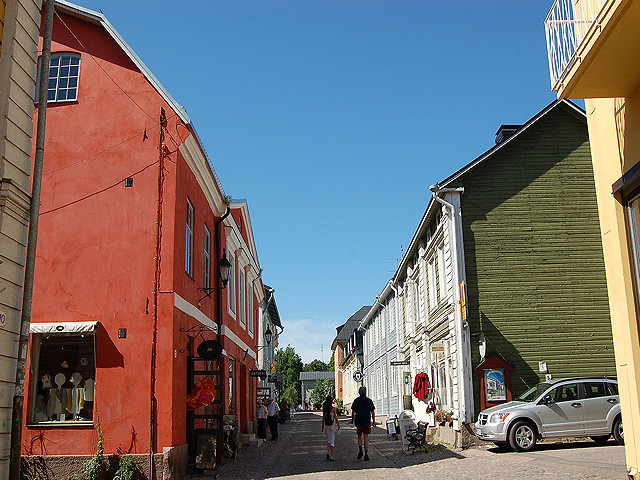 Porvoo (Borgå) 'Old Town' a dense mediaeval street pattern with predominantly wooden houses. The central point of the old town is the medieval, stone and brick.
Porvoo (Borgå) 'Old Town' a dense mediaeval street pattern with predominantly wooden houses. The central point of the old town is the medieval, stone and brick.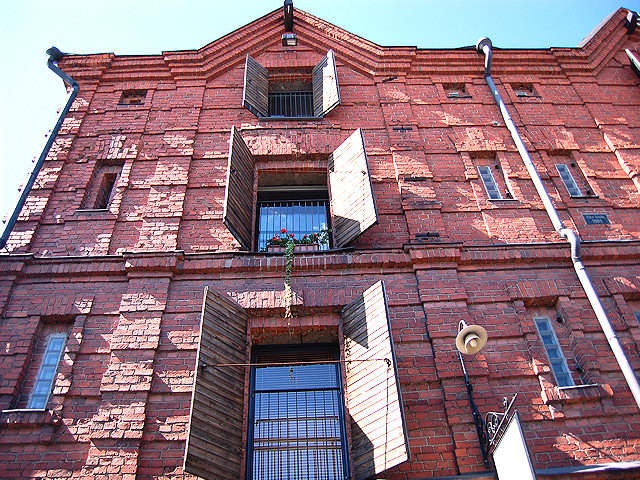 Café sympa près de la rivière Porvoonjoki à Porvoo, Finlande
Café sympa près de la rivière Porvoonjoki à Porvoo, Finlande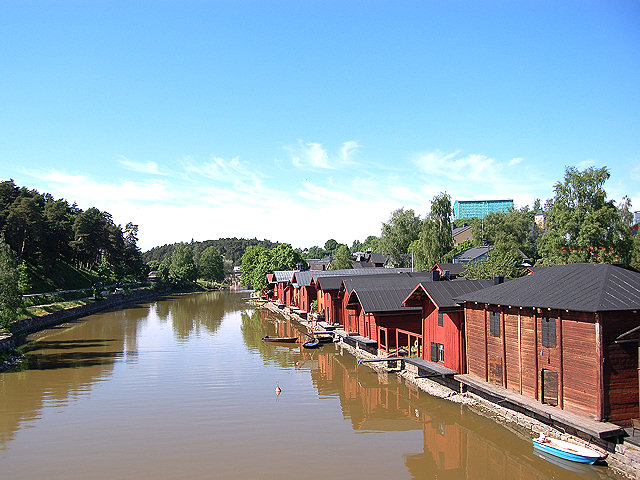 Riverside storage buildings in Old Porvoo, southern coast of Finland
Riverside storage buildings in Old Porvoo, southern coast of Finland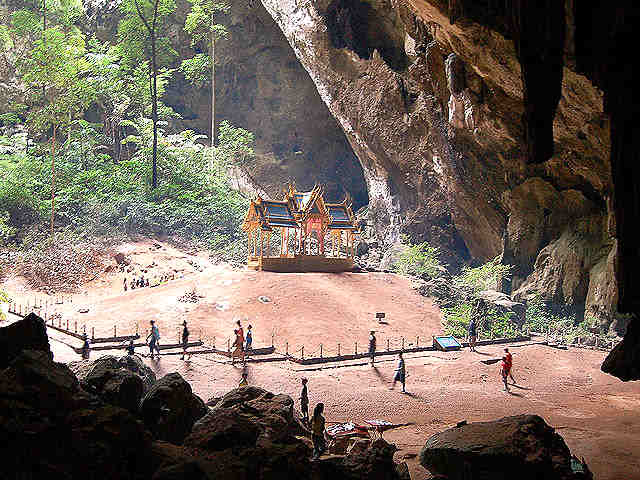 Later kings also visited the area, especially the Phraya Nakhon cave. The cave consists of two caverns, illuminated by the collapsed roofs. For the visit of King Chulalongkorn in 1890 the Kuha Karuhas pavillon was built inside the cave. Later King Vajiravudh as well as the current king Bhumibol Adulyadej visited the cave. The Khao Sam Roi Yot National Park was created on June 28 1966. It was enlarged on April 1, 1982.
Later kings also visited the area, especially the Phraya Nakhon cave. The cave consists of two caverns, illuminated by the collapsed roofs. For the visit of King Chulalongkorn in 1890 the Kuha Karuhas pavillon was built inside the cave. Later King Vajiravudh as well as the current king Bhumibol Adulyadej visited the cave. The Khao Sam Roi Yot National Park was created on June 28 1966. It was enlarged on April 1, 1982.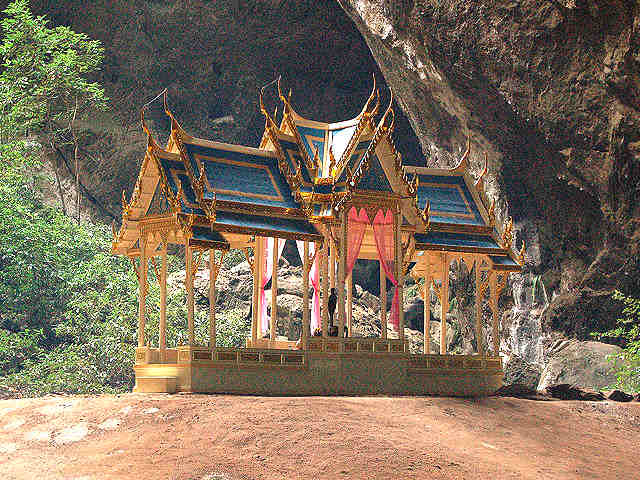 Phraya Nakhon cave with the Kuha Karuhas pavillon. The area of the Khao Sam Roi Yot was probably the site where King Mongkut convened with European guests on August 18, 1868 to observe a total solar eclipse. The king was very interested in astronomy and had calculated the date and location of the eclipse himself. However he contracted malaria during that event, and died shortly later - Khao Sam Roi Yot National Park (Thai: เขาสามร้อยยอด), Sam Roi Yot district, Prachuap Khiri Khan Province, Thailand
Phraya Nakhon cave with the Kuha Karuhas pavillon. The area of the Khao Sam Roi Yot was probably the site where King Mongkut convened with European guests on August 18, 1868 to observe a total solar eclipse. The king was very interested in astronomy and had calculated the date and location of the eclipse himself. However he contracted malaria during that event, and died shortly later - Khao Sam Roi Yot National Park (Thai: เขาสามร้อยยอด), Sam Roi Yot district, Prachuap Khiri Khan Province, Thailand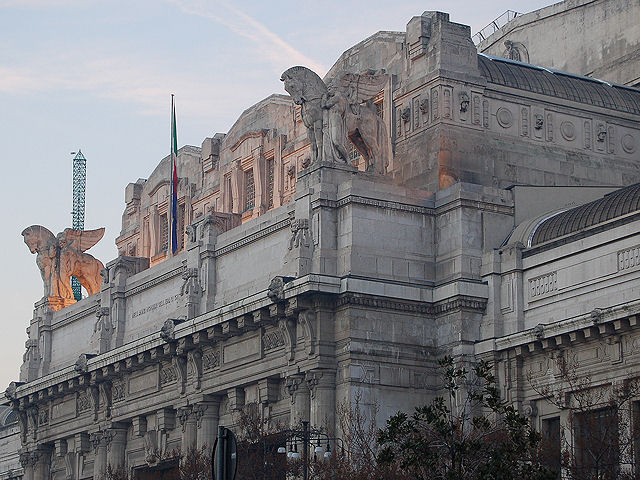 Milan Central Station (Italian: Stazione Centrale di Milano or Milano Centrale), railway terminus officially inaugurated in 1931, Milan (Milano), Italy
Milan Central Station (Italian: Stazione Centrale di Milano or Milano Centrale), railway terminus officially inaugurated in 1931, Milan (Milano), Italy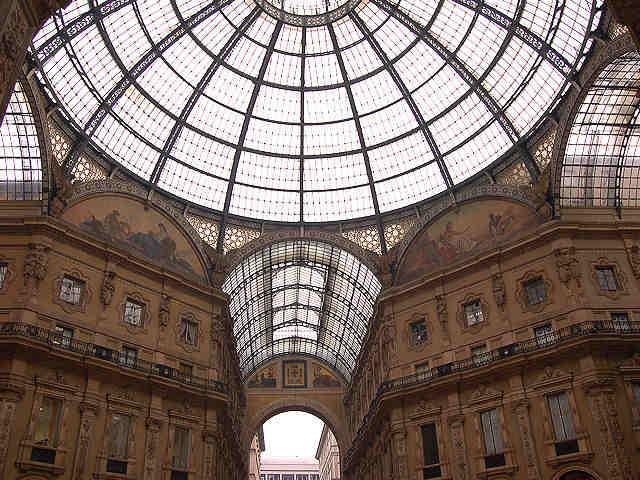 Galleria Vittorio Emanuele II from inside the arcade, built by Giuseppe Mengoni between 1865 and 1877, northern side of the Piazza del Duomo in Milan
Galleria Vittorio Emanuele II from inside the arcade, built by Giuseppe Mengoni between 1865 and 1877, northern side of the Piazza del Duomo in Milan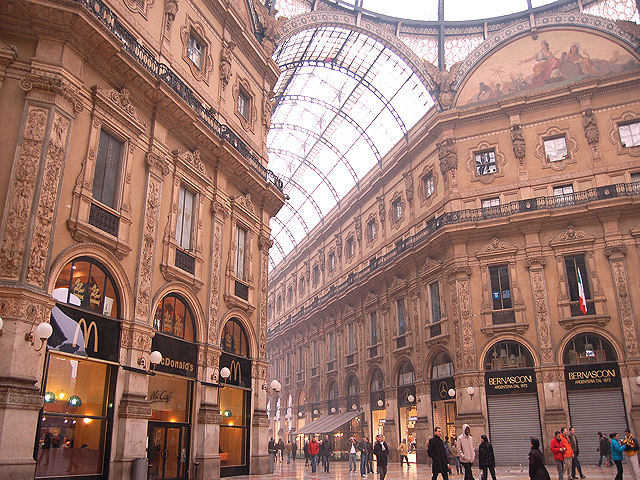 Galleria Vittorio Emanuele II is a covered double arcade formed of two glass-vaulted arcades at right angles intersecting in an octagon; it is prominently sited on the northern side of the Piazza del Duomo in Milan, and connects to the Piazza della Scala. Named after Vittorio Emanuele II, the first king of united Italy, it was originally designed in 1861 and built by Giuseppe Mengoni between 1865 and 1877.
Galleria Vittorio Emanuele II is a covered double arcade formed of two glass-vaulted arcades at right angles intersecting in an octagon; it is prominently sited on the northern side of the Piazza del Duomo in Milan, and connects to the Piazza della Scala. Named after Vittorio Emanuele II, the first king of united Italy, it was originally designed in 1861 and built by Giuseppe Mengoni between 1865 and 1877.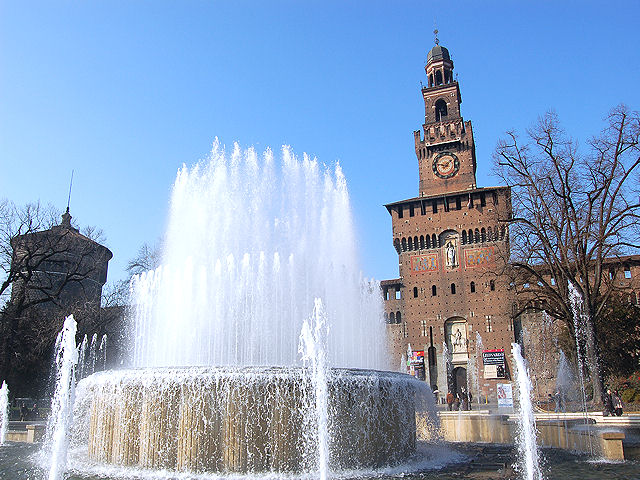 Fountain in front of the Torre del Filarete. In the main entrance to the Ducal Courtyard museums is a stairway leading to the Rocchetta first and second floors, which house the Sforzesco Castle Applied art collections. On the first floor is the so-called Sala della Balla, where ladies and knights at the Sforza Court used to amuse themselves. Here are the magnificent Trivulzio Tapestries, manufactured in Vigevano according to Bramantino's cartoons. In the ball room are also some of the exhibits belonging to the museum of musical instruments. The collection was acquired by the city of Milan starting from the '50s with the Gallini Collection, but includes also a wide range of other exhibits, in particular stringed instruments from Lombardy. In the following rooms are 16th and 17th century lutes, arch lutes, zithers, guitars, and strings that made families from Cremona (the Amati and the Guarneri) renowned in the 17th century. The wind instruments deserve great attention too, to begin with the old hunting horns, the numerous wood instruments (e.g. flutes, oboes, clarinets, English horns) and the bassoons. There are also many valuable exhibits, such as Mango Longo's ten-string guitar, a 16th century harpsichord of the Venice school, Johannes Maria Anciuti's oboe (1722) and a rare glass harmonica, which had once belonged to Pietro Verri. Not to be forgotten, a section with a collection of non-European instruments and two rooms (room XXXIV and room XXXV) with a collection of instruments donated to the castle museum by the Antonio Monzino Foundation in 2000. On the second floor of the Rocchetta is exhibited a great variety of decorative arts from Lombardy, including artistic ceramics, antique furniture, ivories dating from the 4th to the 18th centuries, enamelware from Limoges scientific instruments and time meters. Among the ivory, the consul's diptychs and the Trivulzio little plate, on which emperor Ottone's family is portrayed, deserve particular attention, among the jewellery, Voghera's monstrance must be mentioned. There are interesting wrought iron exhibits, as well as glassware, majolica and china, put in chronological order, from the Middle Ages until the 19th century. Some works are by great majolica painters of the Renaissance - e.g. Francesco Xanto Avelli and Nicola da Urbino - some other by the most important china factories of the 18th century in Europe - e.g. Meissen, Vienna, Capodimonte and Ginori of Doccia.
Fountain in front of the Torre del Filarete. In the main entrance to the Ducal Courtyard museums is a stairway leading to the Rocchetta first and second floors, which house the Sforzesco Castle Applied art collections. On the first floor is the so-called Sala della Balla, where ladies and knights at the Sforza Court used to amuse themselves. Here are the magnificent Trivulzio Tapestries, manufactured in Vigevano according to Bramantino's cartoons. In the ball room are also some of the exhibits belonging to the museum of musical instruments. The collection was acquired by the city of Milan starting from the '50s with the Gallini Collection, but includes also a wide range of other exhibits, in particular stringed instruments from Lombardy. In the following rooms are 16th and 17th century lutes, arch lutes, zithers, guitars, and strings that made families from Cremona (the Amati and the Guarneri) renowned in the 17th century. The wind instruments deserve great attention too, to begin with the old hunting horns, the numerous wood instruments (e.g. flutes, oboes, clarinets, English horns) and the bassoons. There are also many valuable exhibits, such as Mango Longo's ten-string guitar, a 16th century harpsichord of the Venice school, Johannes Maria Anciuti's oboe (1722) and a rare glass harmonica, which had once belonged to Pietro Verri. Not to be forgotten, a section with a collection of non-European instruments and two rooms (room XXXIV and room XXXV) with a collection of instruments donated to the castle museum by the Antonio Monzino Foundation in 2000. On the second floor of the Rocchetta is exhibited a great variety of decorative arts from Lombardy, including artistic ceramics, antique furniture, ivories dating from the 4th to the 18th centuries, enamelware from Limoges scientific instruments and time meters. Among the ivory, the consul's diptychs and the Trivulzio little plate, on which emperor Ottone's family is portrayed, deserve particular attention, among the jewellery, Voghera's monstrance must be mentioned. There are interesting wrought iron exhibits, as well as glassware, majolica and china, put in chronological order, from the Middle Ages until the 19th century. Some works are by great majolica painters of the Renaissance - e.g. Francesco Xanto Avelli and Nicola da Urbino - some other by the most important china factories of the 18th century in Europe - e.g. Meissen, Vienna, Capodimonte and Ginori of Doccia.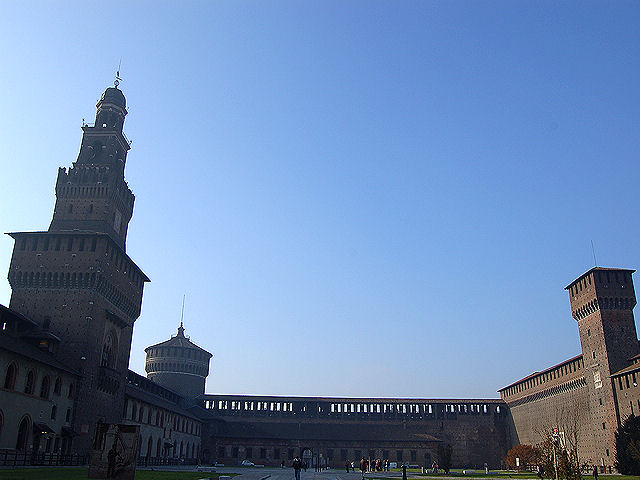 Castello Sforzesco global view. The best known of the current civic museums is the Pinacoteca del Castello Sforzesco, with an art collection which includes Michelangelo's last sculpture, the Rondanini Pietà, Andrea Mantegna's Trivulzio Madonna and Leonardo da Vinci's Codex Trivulzianus manuscript. The Castello complex also includes The Museum of Ancient Art, The Furniture Museum, The Museum of Musical Instruments and the Applied Arts Collection, The Egyptian and Prehistoric sections of the Archaeological Museum and the Achille Bertarelli Print Collection.
Castello Sforzesco global view. The best known of the current civic museums is the Pinacoteca del Castello Sforzesco, with an art collection which includes Michelangelo's last sculpture, the Rondanini Pietà, Andrea Mantegna's Trivulzio Madonna and Leonardo da Vinci's Codex Trivulzianus manuscript. The Castello complex also includes The Museum of Ancient Art, The Furniture Museum, The Museum of Musical Instruments and the Applied Arts Collection, The Egyptian and Prehistoric sections of the Archaeological Museum and the Achille Bertarelli Print Collection.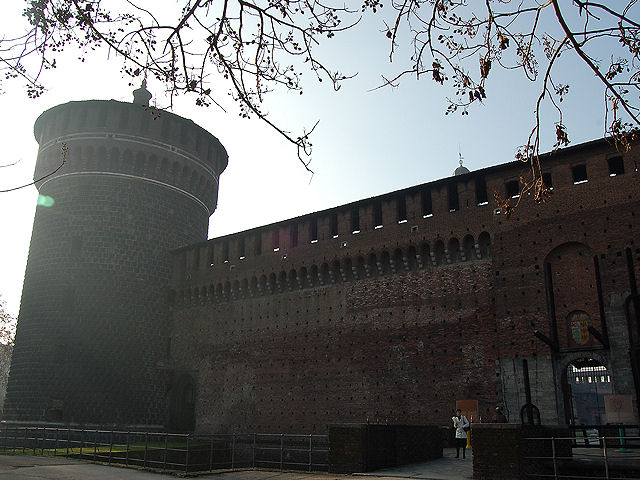 Château Sforza - un château à Milan, Italie
Château Sforza - un château à Milan, Italie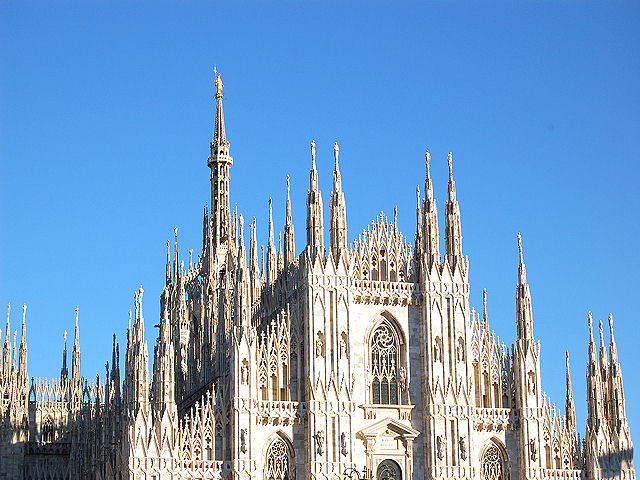 La cathédrale de Milan, Lombardie, Italie
La cathédrale de Milan, Lombardie, Italie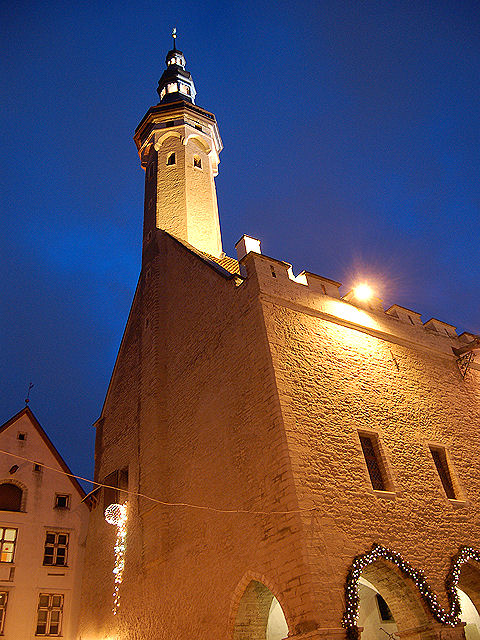 The tower was constructed together with the Town Hall in 1402 - 1404. The original Gothic pyramidal spire was replaced by a Late-Renaissance spire in 1627. The height of the Town Hall from the bottom of the arcade to the top of the spire is 64 meters.
A weather-wane - the figure of an old warrior called Old Thomas was put on top of the spire already in 1530. Old Thomas kept watch until 1944 when it was hit at the time of the March bombardment. Old Thomas is now exhibited in the Citizens' Hall of the Town Hall. The burnt spire was reconstructed and a new copy of Old Thomas erected in 1952. In 1996 the spire was renovated and the third Old Thomas figure was put on top of the spire.
The tower was constructed together with the Town Hall in 1402 - 1404. The original Gothic pyramidal spire was replaced by a Late-Renaissance spire in 1627. The height of the Town Hall from the bottom of the arcade to the top of the spire is 64 meters.
A weather-wane - the figure of an old warrior called Old Thomas was put on top of the spire already in 1530. Old Thomas kept watch until 1944 when it was hit at the time of the March bombardment. Old Thomas is now exhibited in the Citizens' Hall of the Town Hall. The burnt spire was reconstructed and a new copy of Old Thomas erected in 1952. In 1996 the spire was renovated and the third Old Thomas figure was put on top of the spire.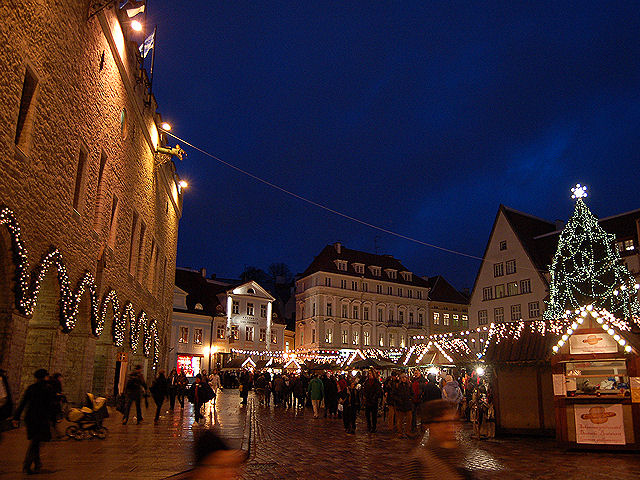 Like any typical European city, Tallinn is centred around its main square; and in the Estonian capital, it is known locally as Raekoja Plats or to the tourists as Town Hall Square.
The main building on the Town Hall Square is obviously Town Hall, or Tallinna Raekoda. Although the building was built over 600 years ago, it has kept to its original use and externally looks much the same as it did during its completion. The Town Hall Tower rises about 40 metres (about 130 feet) over the Square, and affords an amazing view over the Old Town and towards Toompea Hill. Although there are only a little over a hundred steps to reach the top of the tower, the higher you get, the larger the steps become, with some steps near the top approaching 18 inches (almost half a metre). The climb up is quite narrow, though there were occasional alcoves along the way in case you needed to catch your breath, or wanted to see what the Estonians used for a toilet over 500 years ago! The climb didn't seem like it was too high on the other Tallinn visitors' lists as we encountered no-one during the climb or at the top; which was probably all the better since there was only room for about four people at the top anyway. The view from the top was well worth the climb, and since we had a pristine day, you could see for miles. The tower is open from June through August, 11am to 6pm, and costs 30EEK (though half-price for students, children, and senior citizens). On a clear day it is well worth the effort! The same price is charged for entrance into the Town Hall itself, though if you want to take a tour, be ready to fork out another 300EEK on top of the entrance fee. During the summer the town hall is open daily, but visits from September through May require a prior appointment.
Like any typical European city, Tallinn is centred around its main square; and in the Estonian capital, it is known locally as Raekoja Plats or to the tourists as Town Hall Square.
The main building on the Town Hall Square is obviously Town Hall, or Tallinna Raekoda. Although the building was built over 600 years ago, it has kept to its original use and externally looks much the same as it did during its completion. The Town Hall Tower rises about 40 metres (about 130 feet) over the Square, and affords an amazing view over the Old Town and towards Toompea Hill. Although there are only a little over a hundred steps to reach the top of the tower, the higher you get, the larger the steps become, with some steps near the top approaching 18 inches (almost half a metre). The climb up is quite narrow, though there were occasional alcoves along the way in case you needed to catch your breath, or wanted to see what the Estonians used for a toilet over 500 years ago! The climb didn't seem like it was too high on the other Tallinn visitors' lists as we encountered no-one during the climb or at the top; which was probably all the better since there was only room for about four people at the top anyway. The view from the top was well worth the climb, and since we had a pristine day, you could see for miles. The tower is open from June through August, 11am to 6pm, and costs 30EEK (though half-price for students, children, and senior citizens). On a clear day it is well worth the effort! The same price is charged for entrance into the Town Hall itself, though if you want to take a tour, be ready to fork out another 300EEK on top of the entrance fee. During the summer the town hall is open daily, but visits from September through May require a prior appointment.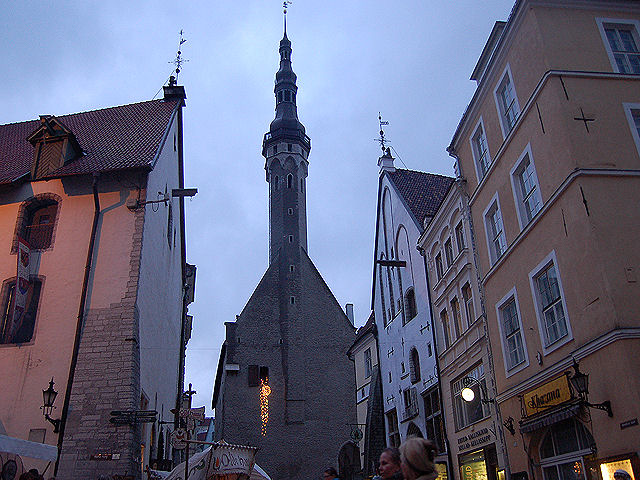 Tallinn Town Hall, first built as an impressive residence of the town council, is located in the Old Town, on the south side of Raekoja Square. It is an oblong two-storey building, constructed of local limeston.
Tallinn Town Hall, first built as an impressive residence of the town council, is located in the Old Town, on the south side of Raekoja Square. It is an oblong two-storey building, constructed of local limeston.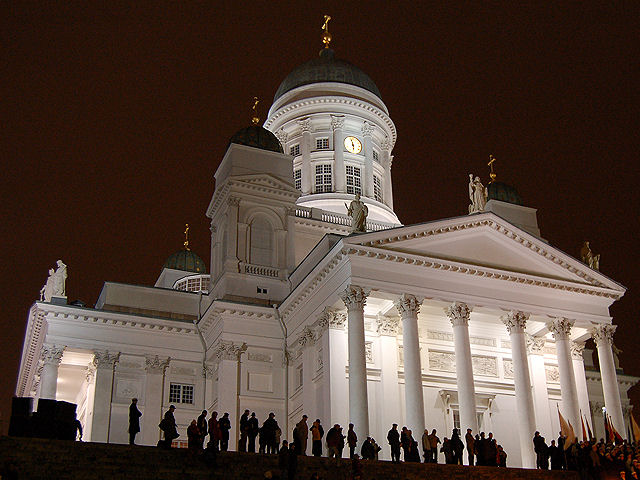 Helsinki Cathedral (Helsingin tuomiokirkko or Suurkirkko). Night light of Finland's Independence Day (Finnish itsenäisyyspäivä, Swedish självständighetsdag) is a national public holiday held on December 6 to celebrate Finland's declaration of independence from the Russian empire. The movement for Finland's Independence started after the revolutions in Russia (1917), caused by the disturbances from the defeats of the First World War. This gave an opportunity for Finland to withdraw from Russia. After several disagreements between the non-socialists and the social-democrats about the matter of who should have the power in Finland, the parliament, led by Per Evind Svinhufvud, finally declared Finland as an independent state, on the 6th of December 1917.
During the early decades of independence, this day was a very solemn occasion marked by patriotic speeches and special Church services. From the 1970s onwards, however, Independence day celebrations have taken on livelier forms, with shops decorating their windows in the blue and white of the Finnish flag, and bakeries producing cakes with blue and white icing. Today, rock stars and entertainers have been accepted as worthy interpreters of Finnish patriotism.
It is traditional for Finnish families to light two candles in the windows of their home in the evening, Historically these two candles were used as a sign to inform Finnish Jäger troops that the house was ready to offer shelter and keep them hidden from the Russians.
Helsinki Cathedral (Helsingin tuomiokirkko or Suurkirkko). Night light of Finland's Independence Day (Finnish itsenäisyyspäivä, Swedish självständighetsdag) is a national public holiday held on December 6 to celebrate Finland's declaration of independence from the Russian empire. The movement for Finland's Independence started after the revolutions in Russia (1917), caused by the disturbances from the defeats of the First World War. This gave an opportunity for Finland to withdraw from Russia. After several disagreements between the non-socialists and the social-democrats about the matter of who should have the power in Finland, the parliament, led by Per Evind Svinhufvud, finally declared Finland as an independent state, on the 6th of December 1917.
During the early decades of independence, this day was a very solemn occasion marked by patriotic speeches and special Church services. From the 1970s onwards, however, Independence day celebrations have taken on livelier forms, with shops decorating their windows in the blue and white of the Finnish flag, and bakeries producing cakes with blue and white icing. Today, rock stars and entertainers have been accepted as worthy interpreters of Finnish patriotism.
It is traditional for Finnish families to light two candles in the windows of their home in the evening, Historically these two candles were used as a sign to inform Finnish Jäger troops that the house was ready to offer shelter and keep them hidden from the Russians.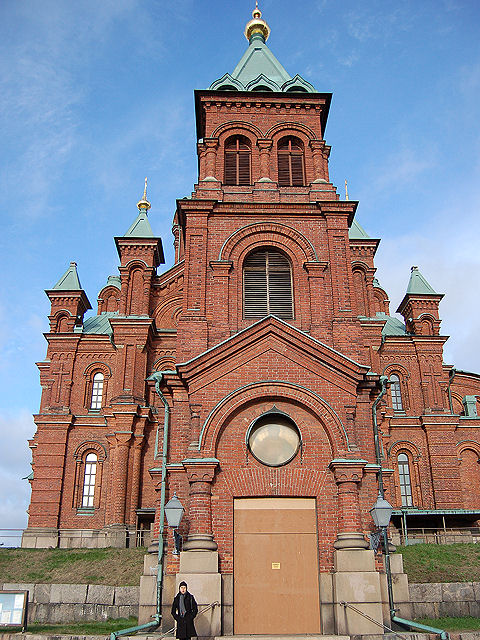 Uspenski Cathedral (Uspenskin katedraali) was built in the Russian Byzantine style in 1862-1868, and is the biggest Orthodox church in western Europe. It was designed by Aleksei Gornostajev, and was styled after an old church built in the 16th century near Moscow in Russia. The bricks were brought from Bomarsund fortress in Aland which had been destroyed during the Crimean War in 1854. The dome is held by four monolithic granite pillars. Altogether, the cathedral has 13 golden onions which represent the number of the Christ and the Apostles.
Uspenski Cathedral (Uspenskin katedraali) was built in the Russian Byzantine style in 1862-1868, and is the biggest Orthodox church in western Europe. It was designed by Aleksei Gornostajev, and was styled after an old church built in the 16th century near Moscow in Russia. The bricks were brought from Bomarsund fortress in Aland which had been destroyed during the Crimean War in 1854. The dome is held by four monolithic granite pillars. Altogether, the cathedral has 13 golden onions which represent the number of the Christ and the Apostles.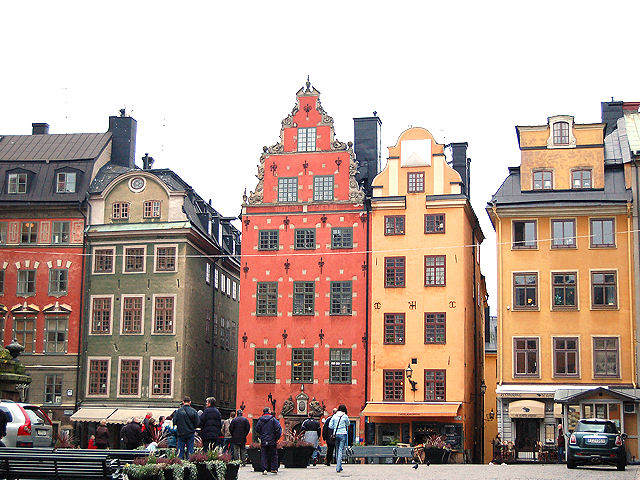 Iconic buildings surrounding the square Stortorget. Gamla stan (Old Town), until 1980 officially Staden mellan broarna (The Town between the Bridges), is the old town of Stockholm, Sweden. Gamla stan consists primarily of the island Stadsholmen. The surrounding islets Riddarholmen, Helgeandsholmen, and Strömsborg are officially part of, but not colloquially included in, Gamla stan.
Iconic buildings surrounding the square Stortorget. Gamla stan (Old Town), until 1980 officially Staden mellan broarna (The Town between the Bridges), is the old town of Stockholm, Sweden. Gamla stan consists primarily of the island Stadsholmen. The surrounding islets Riddarholmen, Helgeandsholmen, and Strömsborg are officially part of, but not colloquially included in, Gamla stan.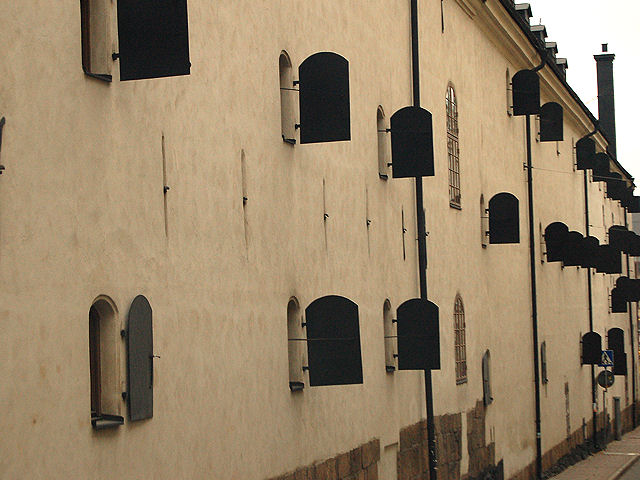 The Museum's exhibitions are accessible to children as well as adults. Here you can see, listen to, and even touch and play many of the instruments. Current themes at the Museum are the influence on society of music and instruments, and the possibility for visitors, alone or in groups, to make their own music.
A house full of musical adventures at Stockholm Sweden.
The Museum's exhibitions are accessible to children as well as adults. Here you can see, listen to, and even touch and play many of the instruments. Current themes at the Museum are the influence on society of music and instruments, and the possibility for visitors, alone or in groups, to make their own music.
A house full of musical adventures at Stockholm Sweden.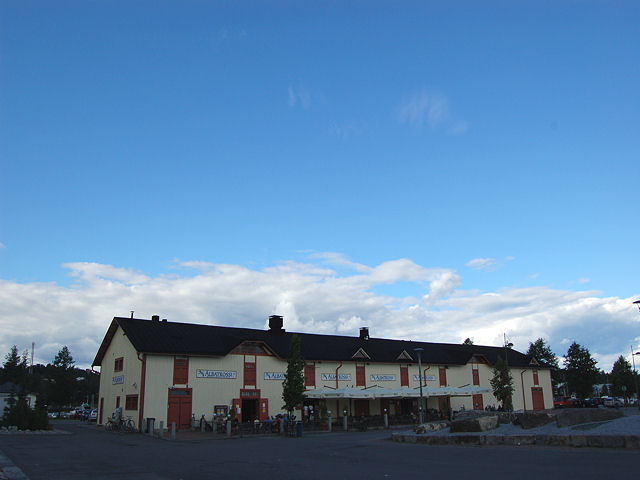 In Finland the inhabitants of Kuopio have a special reputation: they are known as jovial, verbally joking and lacking self-irony. People of Kuopio region and Eastern Finland have always had many health problems and the mortality has been higher than on an average in Finland. During the 2000s Kuopio has placed very well in many image, popularity and city-attractiveness -queries. It has always been near the top among the Finnish cities.
In Finland the inhabitants of Kuopio have a special reputation: they are known as jovial, verbally joking and lacking self-irony. People of Kuopio region and Eastern Finland have always had many health problems and the mortality has been higher than on an average in Finland. During the 2000s Kuopio has placed very well in many image, popularity and city-attractiveness -queries. It has always been near the top among the Finnish cities.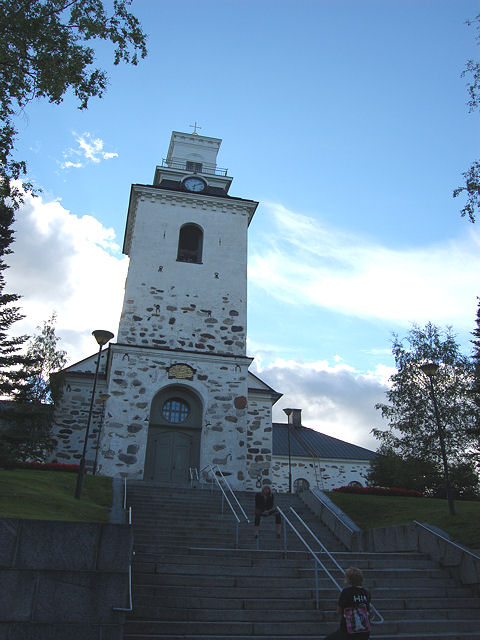 The Kuopio region is situated in central Finland, in the verdant province of North Savo, which is interspersed with thousands of lakes. The region can be reached in less than an hour by air from Helsinki, the capital of Finland, and by road or rail the journey only takes a few hours.
The Kuopio region is situated in central Finland, in the verdant province of North Savo, which is interspersed with thousands of lakes. The region can be reached in less than an hour by air from Helsinki, the capital of Finland, and by road or rail the journey only takes a few hours.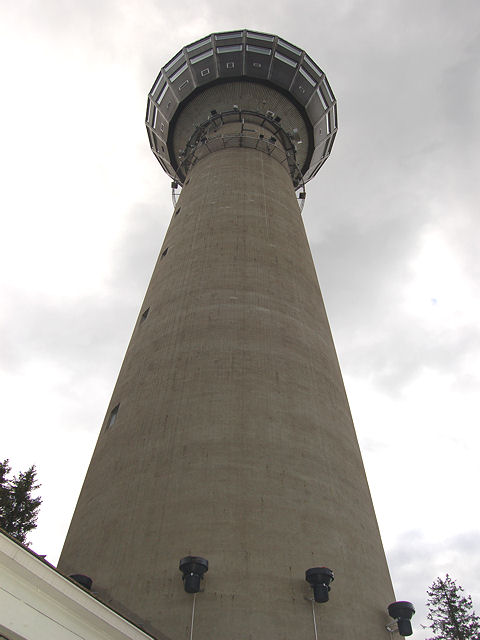 Puijo tower (Puijon torni), built in 1963 (3rd; 2nd from 1906 was demolished when this was completed; 1st was built in 1856), Kuopio, Eastern Finland
Puijo tower (Puijon torni), built in 1963 (3rd; 2nd from 1906 was demolished when this was completed; 1st was built in 1856), Kuopio, Eastern Finland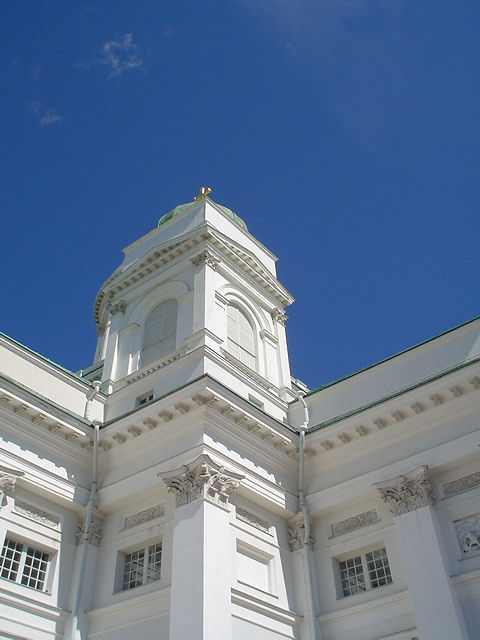 The Helsinki Cathedral (in Finnish Helsingin tuomiokirkko or Suurkirkko, in Swedish Helsingfors domkyrka) is an Evangelical Lutheran cathedral and the seat of the Diocese of Helsinki, located in the centre of Helsinki, Finland. The church was built as a tribute to the Grand Duke, Nicholas I, the Tsar of Russia and until the independence of Finland in 1917, it was called St. Nicholas' Church
The Helsinki Cathedral (in Finnish Helsingin tuomiokirkko or Suurkirkko, in Swedish Helsingfors domkyrka) is an Evangelical Lutheran cathedral and the seat of the Diocese of Helsinki, located in the centre of Helsinki, Finland. The church was built as a tribute to the Grand Duke, Nicholas I, the Tsar of Russia and until the independence of Finland in 1917, it was called St. Nicholas' Church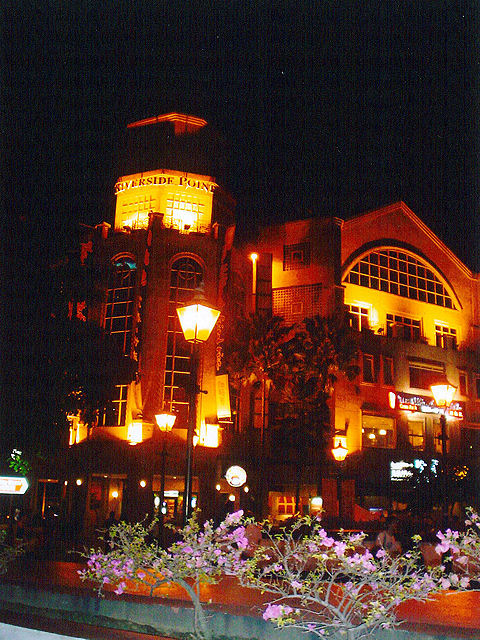 Hotel nightlight at Clarke Quay area, historical riverside quay in Singapore, located within the Singapore River Planning Area. The quay is situated upstream from the mouth of the Singapore River and Boat Quay
Hotel nightlight at Clarke Quay area, historical riverside quay in Singapore, located within the Singapore River Planning Area. The quay is situated upstream from the mouth of the Singapore River and Boat Quay